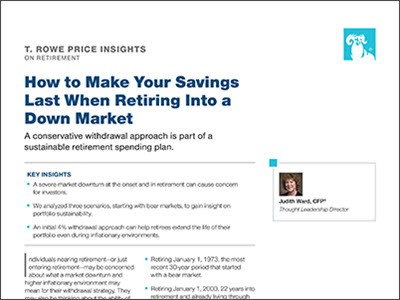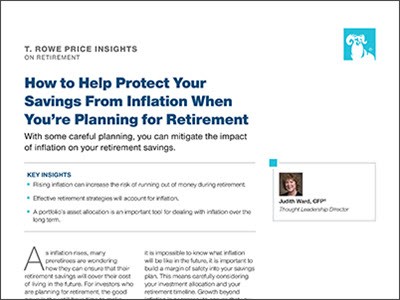Client Conversations
How to Assure Worried Investors Near or in Retirement
September 01 2022Share these resources with individuals who are worried about falling markets and rising inflation.
Inflation and a severe market turndown are always of concern for investors. They’re especially tricky for those at the point of retirement because beginning a withdrawal strategy while markets are down and prices are soaring can be scary. Managing conversations with your clients about these kinds of issues—while difficult—can help cement your relationship so they truly see you as their go-to advisor.
To help you with this, T. Rowe Price has published two resources you can share with retirees and pre-retirees. The first focuses on making their savings last in a down market, and the second explores the strategies an investor can use to protect themselves from inflation.
Guarding Retirement Assets in a Down Market
In How to Make Your Savings Last in a Down Market, we examine some hypothetical examples of retiree portfolios during periods of pronounced weakness in stock prices. One key lesson from the article is that the sequence of returns matters considerably for a person’s retirement withdrawal strategy. Market declines within the first five years of drawing down retirement assets can significantly impact the longevity of their nest egg, especially when planning for a retirement horizon that could span decades.
However, assuming a retiree decides to withdraw a conservative amount each year (e.g., 4%) from a balanced portfolio, they can still weather not one, but two significant market declines over the course of their retirement. A case in point is someone who stopped working in 2000. An individual in this situation would see their portfolio suffer during the 2000-2002 crash, as well as the 2007-2008 drawdown associated with the global financial crisis. By 2021, though, the account balance would exceed the initial value upon retirement.
Retiring in 2000
Retirees in 2000 faced two massive market declines in the first 10 years of their retirement1
The good news—with your help, there are steps retirees can take to protect their retirement from the threat of a bear market. They may wish to adopt a conservative withdrawal approach and adjust spending in order to sustain their portfolio’s balance.
Maintaining Purchasing Power in Retirement
Using the second resource, How Retirees Can Protect Their Savings from Rising Inflation, you can address retirees’ concerns about the erosion of the real value of their savings. This article explains that a healthy allocation to stocks can offer some inflation protection.
Diversification Can Safeguard an Investor’s Retirement
Clients with stocks in their portfolios can be better protected against inflation.
In addition, they may wish to adjust their spending temporarily and keep a decent cash cushion as a safety net against further increases in consumer prices.
Demonstrate Your Value as a Financial Professional
Times like these can be scary for investors approaching, and in, retirement. They need and want reassurance. Sharing resources like these shows that you empathize with these individuals’ situation—and are committed to helping them achieve the retirement they want.
1 We used the Monte Carlo analysis and assumed the following: an 87-year-old living with no spouse/partner in retirement with a balance of $508,361 as of 3/31/22 and a hypothetical portfolio composed of 60% stocks and 40% bonds and ongoing monthly withdrawals from the portfolio starting at $2,753 and increasing 3%, 5%, 7%, and 9% annually to account for inflation. This resulted in a simulation success rate (i.e., the investor has at least $1 remaining in the portfolio at the end of retirement) of 99% in each of the 4 examples based on 1,000 market scenarios. No Social Security or other income was considered as we were only assessing the impact of withdrawals on personal savings. To assess a further decline of 20%, we decreased the starting portfolio balance to $406,688 and increased the $2,753 monthly withdrawal amount by 9% annually which resulted in a simulation success rate of 93%.
ASSUMPTIONS
The hypothetical examples above are based on the performance of the S&P 500 Index, which tracks the performance of 500 large-company stocks, and the Bloomberg U.S. Aggregate Bond Index, which tracks domestic investment-grade bonds, including corporate, government, and mortgage-backed securities, for the time periods represented. Indexes are unmanaged, and it is not possible to invest directly in an index. These hypothetical examples are meant for illustrative purposes only and do not reflect an actual investment, nor do they account for the effects of taxes or any investment expenses. Investment returns are not guaranteed, cannot be predicted, and will fluctuate. All investments are subject to risk, including the possible loss of the money invested.
IMPORTANT: The projections or other information generated by the Monte Carlo analysis regarding the likelihood of various investment outcomes are hypothetical in nature, do not reflect actual investment results, and are not guarantees of future results. The projections are based on assumptions. There can be no assurance that the projected results will be achieved or sustained. The charts present only a range of possible outcomes. Actual results will vary with each use and over time, and such results may be better or worse than the projected scenarios. Clients should be aware that the potential for loss (or gain) may be greater than demonstrated in the projections.
2 Asset Allocation Models:
Within Stocks: 60% U.S. Large-Cap, 25% Developed International, 10% U.S. Small-Cap, 5% Emerging Markets
Within Bonds: 70% U.S. Investment Grade, 10% High Yield, 10% International, 10% Emerging Markets
Within Cash: 100% Money Market Securities, Certificates of Deposit, Bank Accounts, Short-Term Bonds
The use of asset allocation and diversification cannot guarantee a positive result nor can they protect against a loss in a declining market.
These allocations are age-based only and do not take risk tolerance into account. Our asset allocation models are designed to meet the needs of a hypothetical investor with an assumed retirement age of 65 and a withdrawal horizon of 30 years. The model asset allocations are based on analysis that seeks to balance long-term return potential with anticipated short-term volatility. The model reflects our view of appropriate levels of trade-off between potential return and short-term volatility for investors of certain ages or time frames. The longer the time frame for investing, the higher the allocation is to stocks (and the higher the volatility) versus bonds or cash. While the asset allocation models have been designed with reasonable assumptions and methods, the tool provides models based on the needs of hypothetical investors only and has certain limitations: The models do not take into account individual circumstances or preferences, and the model displayed for your investment goal and/or age may not align with your accumulation time frame, withdrawal horizon, or view of the appropriate levels of trade-off between potential return and short-term volatility. Investing consistent with a model allocation does not protect against losses or guarantee future results. Please be sure to take other assets, income, and investments into consideration in reviewing results that do not incorporate that information. Other T. Rowe Price educational tools or advice services use different assumptions and methods and may yield different outcomes.
Important Information
This material has been prepared by T. Rowe Price for general and educational purposes only. This material does not provide recommendations concerning investments, investment strategies, or account types. It is not individualized to the needs of any specific investor and is not intended to suggest that any particular investment action is appropriate for you, nor is it intended to serve as the primary basis for investment decision-making. T. Rowe Price, its affiliates, and its associates do not provide legal or tax advice. Any tax-related discussion contained in this material, including any attachments/links, is not intended or written to be used, and cannot be used, for the purpose of (i) avoiding any tax penalties or (ii) promoting, marketing, or recommending to any other party any transaction or matter addressed herein. Please consult your independent legal counsel and/or tax professional regarding any legal or tax issues raised in this material.
All investments are subject to market risk, including the possible loss of principal. Source for Bloomberg index data: Bloomberg Index Services Ltd. Copyright © 2022, Bloomberg Index Services Ltd. Used with permission. Past performance cannot guarantee future results. All investments involve risk. All charts and tables are shown for illustrative purposes only.
T. Rowe Price Investment Services, Inc. © 2022 T. Rowe Price. All Rights Reserved. T. ROWE PRICE, INVEST WITH CONFIDENCE, and the Bighorn Sheep design are, collectively and/or apart, trademarks of T. Rowe Price Group, Inc.
202208-2382618








